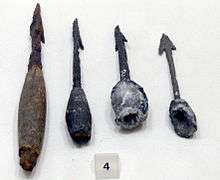Plumbata
 | ||||
| Part of a series on the | ||||
| Military of ancient Rome | ||||
|---|---|---|---|---|
| Structural history | ||||
|
||||
| Campaign history | ||||
| Technological history | ||||
|
||||
| Political history | ||||
|
|
||||
| Strategy and tactics | ||||
|
||||
|
| ||||
Plumbatae or martiobarbuli were lead-weighted darts carried by infantrymen in Antiquity and the Middle Ages.
History
The first examples seem to have been carried by the Ancient Greeks from about 500 B.C. onwards, but the best-known users were the late Roman and Byzantine armies. The best written source for these tactical weapons is Vegetius' De Re Militari (1.17):
- The exercise of the loaded javelins, called martiobarbuli, must not be omitted. We formerly had two legions in Illyricum, consisting of six thousand men each, which from their extraordinary dexterity and skill in the use of these weapons were distinguished by the same appellation. They supported for a long time the weight of all the wars and distinguished themselves so remarkably that the Emperors Diocletian and Maximian on their accession honored them with the titles of Jovian and Herculean and preferred them before all the other legions. Every soldier carries five of these javelins in the hollow of his shield. And thus the legionary soldiers seem to supply the place of archers, for they wound both the men and horses of the enemy before they come within reach of the common missile weapons.[1]
A second source, also from the late 4th century, is an anonymous treatise titled De Rebus Bellicis, which briefly discusses (so far archaeologically unattested) spiked plumbatae (plumbata tribolata), but which is also the only source that shows an image of what a plumbata looked like. The image shows what looks like a short arrow with a weight attached to the shaft. Although only later copies of the original manuscript exist, this is confirmed by the remains which have so far turned up in the archaeological record.
A third source is the late 6th century Strategicon, written by the Byzantine emperor Maurice, who wrote about the martzobarboulon, a corruption of its Latin name martiobarbulum.
Plumbatae etymologically contain plumbum, or lead, and can be translated "lead-weighted [darts]". Martiobarbuli in this translation is mattiobarbuli in the Latin, which is most likely an assimilation of Martio-barbuli, "little barbs of Mars." The barb implied a barbed head, and Mars was the god of war (among other things).
Archaeology gives us a clearer picture of martiobarbuli. The reference listed has an illustration of a find from Wroxeter identified as the head of a plumbata and a reconstruction of the complete weapon: a fletched dart with an iron head weighted with lead. The reconstruction seems entirely consistent with Vegetius' description.
See also
-
 Military of ancient Rome portal
Military of ancient Rome portal - Military of ancient Rome
- Shuriken
- Lawn darts
- Khuru Bhutanese Darts
Notes
- ↑ http://www.digitalattic.org/home/war/vegetius/index.php#b100 De Re Militari Book I: The Selection and Training of New Levies
References
Primary sources
- Anonymous, De Rebus Bellicis: On matters of war.
- Maurice, Strategikon: On Strategy.
- Vegetius, Epitome Rei Militari: Epitome of Military science.
Secondary sources
- Barker, P., The plumbatae from Wroxeter, in: Hassall and Ireland 1979, De Rebus Bellicis, BAR Int. Ser., vol. 63 (Oxford), part 1, pp. 97–9.
- Connolly, Peter, Greece and Rome at War, Greenhill Books, 1998, ISBN 1-85367-303-X
- Degen, R., Plumbatae: Wurfgeschosse der Spätantike, in: Helvetia Archaeologica 1992, vol. 23, pp. 139–147.
- Ireland, Robert, De Rebus Bellicis (anon.), in: BAR International Series 63 (Oxford), part 2.
- Dennis, George T., Maurice's Strategikon. Handbook of Byzantine military strategy, University of Philadelphia Press 1984, ISBN 978-0-8122-1772-8.
- Milner, N.P., Vegetius: epitome of military science, Liverpool University Press 1993, ISBN 0-85323-228-8.
- Völling, T. (1991): Plumbata - Mattiobarbulus - Martzobarboulon? Bemerkungen zu einem Waffenfund aus Olympia in: Archäologischer Anzeiger, pp. 287–98.
External links
| Wikimedia Commons has media related to Category:Plumbatae. |
- I9mage of remains of a plumbata
- Vegetius Book I
- Vegetius in translation
- Modern reproduction of a plumbata
- photo of modern Bhutanese style 'Plumbata'
